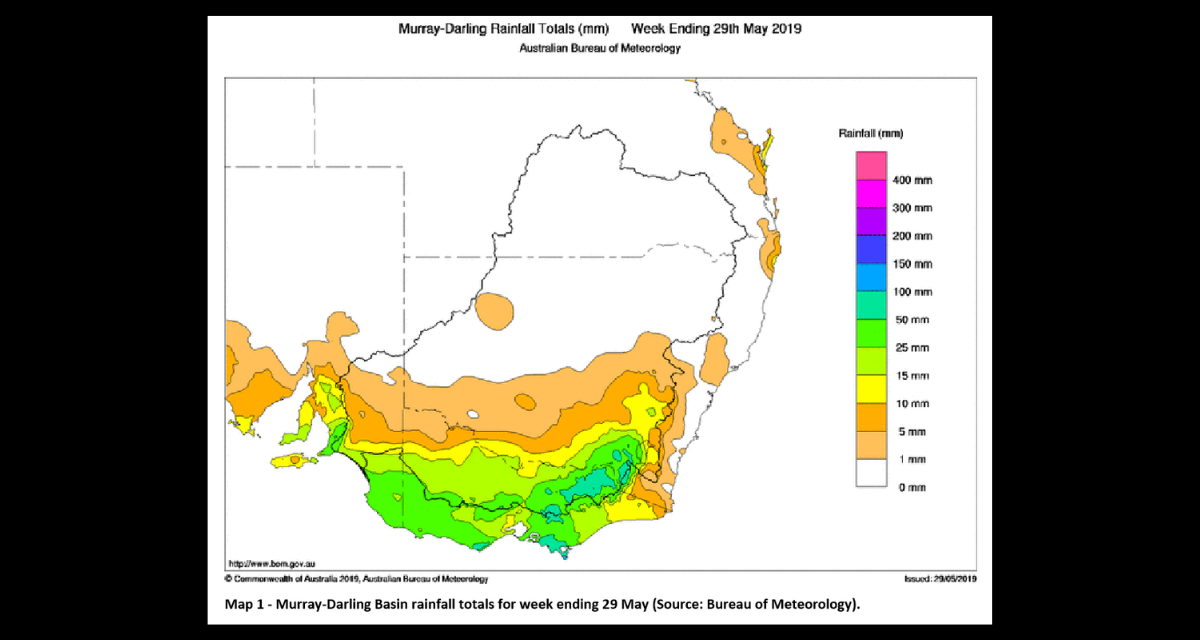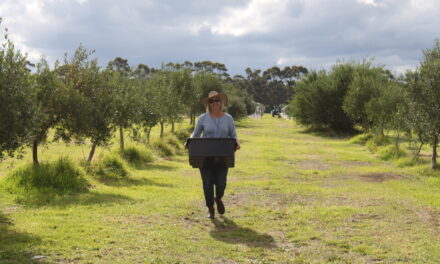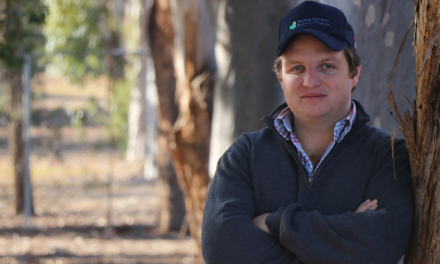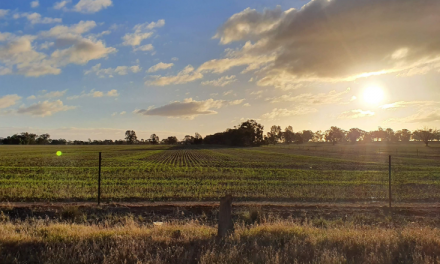Rainfall and inflows
Rainfall for the week ending May 29 was widespread over the southern Murray-Darling Basin with significant totals recorded along the Victorian and New South Wales Alps. The highest Victorian rainfall totals included 102 mm at Mt Buffalo, 80 mm at Harris Lane, 53 mm at Cheshunt in the Ovens River valley and 52 mm at Biggara on the upper Murray. The highest New South Wales rainfall totals were recorded in the Snowy Mountains and included 50 mm at Thredbo and 135 mm at Perisher Valley – two sites located just outside the Basin. Worthwhile totals were also recorded across the south-west slopes and Riverina with 50 mm at Tumbarumba, 20 mm at Mathoura and 14 mm at Wagga Wagga.
Rainfall this week has increased flow in the upper Murray tributaries. On the upper Mitta Mitta River, the flow at Hinnomunjie bridge increased from 370 to 940 ML/day and is forecast to gradually recede over the coming days. The upper Murray at Biggara increased from 310 to around 1,300 ML/day. Downstream of Hume Reservoir, inflow from the Kiewa River, measured at Bandiana, increased from 690 to 1,170 ML/day. On the Ovens River at Bright, the flow peaked at 500 ML/day before receding to around 400 ML/day. Further downstream the flow at Wangaratta increased from 400 to 730 ML/day with further rises likely in the next few days before receding if forecast dry conditions return over the coming days.
River operations
The MDBA active storage volume increased by 32 GL this week to 2,990 GL (35 per cent capacity).
At Dartmouth Reservoir, the storage volume increased by 7 GL to 2,476 GL (64 per cent capacity). Transfers of water from Dartmouth to Hume Reservoir is planned to commence this week. The release from Dartmouth, measured at Colemans, will increase from the current flow of 300 ML/day to 2,200 ML/day by Monday, June 3. Transfers from Dartmouth to Hume are being made to help provide sufficient water in Hume Reservoir to meet future downstream requirements. Over coming months, the requirement for transfers will continue to be assessed and transfers adjusted as necessary. Rainfall and boosted inflows over the coming weeks may decrease transfer requirements under some scenarios. Further information can be found on the MDBA website.
At Hume Reservoir, the storage volume increased by 9 GL to 468 GL (16 per cent capacity). This week’s Hume release has averaged 2,770 ML/day and is currently 1,300 ML/day. Over the coming days the release is expected to reduce further in response to increased tributary inflow downstream of the dam.
Downstream at Lake Mulwala the level is currently at 124.70 m AHD which is within the normal operating range (124.6 to 124.9 m AHD). Irrigation diversions to both Mulwala Canal and Yarrawonga Main Channel (YMC) have ceased for the 2018-19 season, although around 100 ML/day of environmental entitlement continues to pass through YMC and into the lower Broken Creek for the benefit of native fish, before returning to the Murray. The release from Yarrawonga Weir remains near the target flow of 4,000 ML/day. Over the coming week the release from Yarrawonga is expected to increase to around 4,500 ML/day to meet downstream operational requirements.
The Edward and Gulpa offtakes are currently passing 650 and 190 ML/day respectively. As the gates at these regulators are now raised clear of the water, inflows to the Edward-Wakool system will fluctuate over winter in response to flow changes in the River Murray at Picnic Point. The flow at Stevens Weir remained steady around 510 ML/day over the past week.
Inflow to the Murray from the Goulburn River, measured at McCoys Bridge, averaged 970 ML/day. The flow at McCoys will likely remain around this rate into June. From the start of June the majority of this flow will be environmental water being delivered to benefit the local environment. The delivery of Inter Valley Trade (IVT) from the Goulburn to the Murray is planned to cease at the end of May. Information regarding current opportunities for allocation trade between the Goulburn and Murray valleys is available at the Victorian water register website.
National Channel diversions ceased on May 15 as the Victorian gravity irrigation season concluded for 2018-19. In the coming days the diversion to National Channel is expected to increase to around 700 ML/day utilising environmental entitlements to provide flow to Gunbower Creek for the benefit of Murray Cod.
Over the past week the Torrumbarry weir pool has continued to be drawn down to the current level 30 cm below Full Supply Level (FSL). The weir pool level will remain 30 cm below FSL over the coming weeks. It is possible the weir pool will be lowered a further 20 cm in winter depending on flows and river levels at Echuca, before being returned to FSL by early August in time for the commencement of the irrigation season. This action is part of the weir pool variability program and aims to help improve the health of the river banks. River users and landholders in the weir pool should remain aware of the changing water level in case adjustments need to be made to pumps, moorings and recreational activities.
The release downstream of Torrumbarry Weir averaged 3,800 ML/day this week and is expected to ease towards 3,300 ML/day over the coming days. Lock 26 at Torrumbarry remains closed while repairs are made to damaged inlet valves.
Inflows from the Murrumbidgee River, measured at Balranald, averaged around 540 ML/day. This week the Murrumbidgee IVT balance increased above 25 GL, enabling trade into the Murrumbidgee Valley. The WaterNSW website contains information on the current Murrumbidgee IVT account status.
At Euston, the weir pool level is currently 17 cm below FSL and will be lowered to around 30 cm below FSL over the coming weeks. Planning is currently underway to lower the weir pool down to 40-50 cm below FSL during June. The downstream release fluctuated around 7,500 ML/day and is expected to gradually ease over the coming week.
A red level warning (high alert) for blue-green algae remains at Wilcannia on the Darling River and Pooncarie on the lower Darling.
The Menindee Lakes storage volume is 16 GL (1 per cent capacity). WaterNSW continues to manage the Menindee Lakes in accordance with the Lower Darling Annual Operations Plan. As part of drought contingency measures within this plan, WaterNSW has installed four temporary block banks across the lower Darling upstream of Pooncarie at Court Nareen and Karoola, below Pooncarie near Jamesville and below Burtundy near Ashvale. Water held in these pools will assist in maintaining supply to domestic, stock and permanent plantings along the lower Darling. The release from Weir 32 ceased in February. WaterNSW has advised that releases at Weir 32 are only planned to recommence when significant inflows are received into the Menindee lakes. Inflows are currently zero and no significant inflows are expected. Water restrictions remain in place across much of New South Wales as a result of the extensive and on-going drought conditions.
On the Murray at Wentworth Weir, operations continue to target a pool level of around 10 cm above the full supply level to assist pumpers in the upper reaches of the Darling River arm of the weir pool whilst there is no inflow from the Darling River. The downstream release averaged 7,000 ML/day this week.
The Lock 9 weir pool is currently varying between FSL and 10 cm below FSL. As part of the weir pool variability program Lock 8 and 7 water levels are currently lowered. At Lock 8, the weir pool is targeting around 80 cm below FSL during May. The Lock 7 weir pool is currently 5 cm below FSL and will continue to be lowered to a target of 10 cm below FSL.
At Lake Victoria the storage increased by 16 GL to 240 GL (35 per cent capacity). The flow to South Australia is currently targeting 3,600 ML/day. The current flow is being slightly boosted by a relatively small amount of environmental water delivered from Broken Creek and the Campaspe River.
Local rainfall helped boost the Lower Lakes five-day average water level to 0.58 m AHD. Over the last several months environmental water delivered to South Australia has helped to slow the rate of fall at the Lower Lakes and prolong small barrage releases, when wave and tidal conditions allow, to support fish condition and improve salinity levels in the Coorong. In recent weeks, the Lower Lakes have started to rise again and operations will aim to continue this slow trend in coming weeks. At the same time, opportunities will continue to be sought to make further releases when wind and swell conditions are suited to help maximise the effective use of this water for environmental benefits in the Coorong and Murray Mouth. All fish ways remain open. For more information see the South Australian Department for Environment and Water’s latest River Murray flow report.








